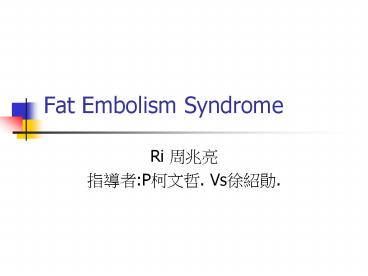Fat Embolism Syndrome - PowerPoint PPT Presentation
1 / 25
Title:
Fat Embolism Syndrome
Description:
First described by Zenker in 1861. Persistent debate has remained as to ... minor signs of tachycardia(HR 120), pyrexia(T 39), thrombocytopenia (plt 150K/uL) ... – PowerPoint PPT presentation
Number of Views:4249
Avg rating:5.0/5.0
Title: Fat Embolism Syndrome
1
Fat Embolism Syndrome
- Ri ???
- ???P???. Vs???.
2
Fat embolism syndrome
- First described by Zenker in 1861.
- Persistent debate has remained as to the
specifics of the diagnosis and management of this
clinical syndrome.
3
- Current concepts of respiratory insufficiency
syndromes after fracture. Journal of Bone
Joint Surgery - British Volume. 83(6)781-91,
2001 Aug. - Fat embolism syndrome. A 10-year review.
Archives of Surgery. 132(4)435-9, 1997 Apr
4
Fat Embolism
- Term fat embolismrefer to the presence of fat
globules in the lung parenchyma and peripheral
circulation - Fat embolism occurs in over 90 of patients after
fracture
5
Fat Embolism syndrome
- Fat embolism syndrome(FES) is a serious
manifestation of respiratory, dermatological and
neurological symptoms. - FES is quite unusual about incidence 1-5 after
long bone fracture.
6
Pathophysiological mechanism
7
Pathophysiological mechanism
- FE can produce tissue damage by direct vascular
occlusion, breakdown to toxic free-fatty acids,
activation of platelets, and coagulative and
fibrinolytic cascades. - FES may occur either from massive FE, paticular
in a patent foramen ovale, or abnormal response
of the individual to intravascular fat.
8
Pathophysiological mechanism
- Histological finding include microvascular
occlusion from fibrin and platelet aggregate,
interstitial leakage of protein and neutrophil
rich fluid, lead to diffuse alveolar damage. - Detectable change include decrease functional
residual capacity, decrease compliance and
increase pulmonary vascular resistance.
9
Diagnosis
- FES remains a diagnosis of exclusion and is based
on clinical criteria
10
Gurd Criteria
- 3 major signs of hypoxia (PaO2lt60mmHg and
FiO2gt0.4), CNS depression, petechiae - minor signs of tachycardia(HRgt120),
pyrexia(Tgt39), thrombocytopenia (pltlt150K/uL),
fat globules in urine or sputum, retinal emboli,
decline in hematocrit cant be accounted for
blood loss or fluid dilution - 1 major and 3 minor or 2 major and 2 minor
11
Incidence
- 27 cases of FES was identified from 3026 pt with
long bone fracture, incidence 0.9 - the mean ISS was 9.5
- 4 pt have all 3 major signs, 16 pt had 2 major
signs, 7 pt had 1 major sign. 6 pt demonstrated
hypoxia as their only major sign.
12
Incidence
13
Fat embolism vs. thromboembolism
- Fat embolism syndrome often occurred within 24-48
hrs after trauma, but thromboembolism is uncommon
sooner than 5 days after immobilization. - Contrast venography is diagnostic gold standard
of thromboembolism.
14
Suggested framework
- Fat embolism is often occurred within 24-48 hr
after injury, but thromboembolism is uncommon
sooner than 5 days after immobilization - To diagnosis thromboembolism, contrast venography
is the gold standard
15
Ventilation-perfusion scans
- It were helpful for excluding pulmonary
embolus(10 of 27 Pt, one was read as multiple
small peripheral defects, others interpreted
negative ) - Emboli tend to be too small to be detected. The
cause of pulmonary damage is direct toxic effect
of free fatty acids rather than to obstruction of
the vascular.
16
Labratory test
- ABG, thrombocytopenia, anemia were all
non-specific - Fat globules in urine(6 of 11), other research
suggested an poor specificity
17
Bronchoalveolar Lavage
- Bronchoalveolar lavage in trauma patients for
diagnosis of fat embolism syndrome. Chest.
19921021323-1327. - It divide three groups (1)26 pt without
trauma.(2)22 pt with trauma and without FES.(3)9
pt with trauma and FES - It exam total cells, neutrophils, macrophages,
fat droplets in macrophages(6/26,9/22,6/9) - presence of fat droplets in alveolar macrophage
is not reliable method for diagnosis of FES after
trauma, many conditions are associated with fat
droplets in alveolar macrophages.
18
Chest X-ray
19
Risk factors of fracture pattern
- The literature suggest a higher incidence of FES
in patient with more than one long bone fracture. - Location clearly favors the lower extremities,
but no greater risk of total fracture population - The paper documented a highter proportion of open
fracture in the group with FES(26) than total
fracture population
20
Management strategies
- Support care
- 12 pt intubation for hypoxia or altered mental
status. - Mean stay in ICU is 6 days, hospital stay is 15
days of intubation pt.
21
Ventilatory strategies
- Lung protective stratery Low tidal volumes,
adequate PEEP. - Pressure-control mood(PCV) and inverse IE ratio
can increase mean distending pressure without
increasing peak pressure. - To achieves SaO2gt90 with FiO2lt0.6 and no
significant cardiac output compromise - prone position
22
Medication
- Heparin, albumin, hypertonic glucose with insulin
all failed to show benefit by studies - corticosteroids human trial have poor control and
showed increasing infection rate. One study
suggests a potential benefit for prophylactic
treatment.
23
Early fracture fixation
- One paper suggest early fracture stabilization
decreases the incidence of FES. The other paper
showed no notable difference, but it dose not
seem to increase incidence of FES.
24
Prognosis
- Pt with FES may have persistent neurological
deficits. - Severe trauma mortality from FES is usually
between 5-15, other are due to other injury or
secondary infection.
25
THE END































